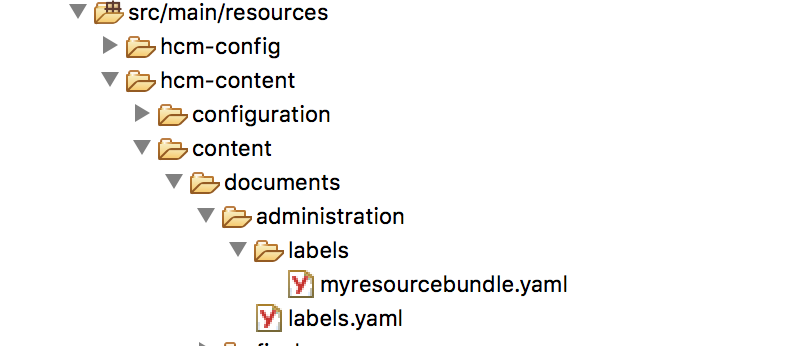Dynamic Resource Bundle Node Structure
Resource Bundle Documents in the Content Repository
The content type of resource bundle documents is defined as follows:
[resourcebundle:resourcebundle] > hippo:document, hippostd:publishableSummary, hippostdpubwf:document orderable - resourcebundle:id (string) mandatory - resourcebundle:keys (string) multiple - resourcebundle:messages (string) multiple - * (string) - * (string) multiple
Here's an explanation for each property:
| Property Definition | Type | Description | Example values |
| resourcebundle:id | string |
The basename of the resource bundle which this resource bundle document is defining. |
org.example.app.Messages |
| resourcebundle:keys | string, multiple | Array of resource bundle keys. This property values are equivalent to all the property key names in a properties resource bundle file, for instance. Note: each item of this value array should map to each item of the value array of "resourcebundle:messages" property. |
{ "greeting.one", "greeting.two" } |
| resourcebundle:messages | string, multiple | Array of resource bundle messages for the default locale. This property values are equivalent to all the property values in a properties resource bundle file, for instance. Note: each item of this value array should map to each item of the value array of "resourcebundle:keys" property. |
{ "Hello!", "Hippo!" } |
| * (string) | string | This property exists for any potential extension points. For example, you might want to put some custom properties for your specific needs, for instance. | - "myproject:specialkey" = "special" |
| * (string) multiple | string, multiple |
This property exists to store localized resource bundle messages. For example, if you want to support the locales, "en_US", "fr" and "nl_NL" specifically, then you should add the following property: And, you should add localized resource bundle messages for each locale in these properties. |
- "resourcebundle:messages_en_US" = { "Hello!","Hippo!" } - "resourcebundle:messages_fr" = { "Bonjour!", "Hippo!" } - "resourcebundle:messages_nl_NL" = { "Hallo!", "Hippo!" } |
Please note that you can add documents in any location by the resourcebundle:resourcebundle content node type, but you should keep the resourcebundle:id property unique throughout the repository because the resourcebundle:id property value is used when looking up the resource bundle by the basename.
Also, you can set the message keys and the default locale messages in resourcebundle:keys and resourcebundle:messages properties, and you have to add localized messages in a separated properties named in the pattern, resourcebundle:message_${locale.name}, where ${locale.name} must be replaced by the real locale name such as en_US, fr, nl_NL, etc.
Each value item of resourcebundle:keys property must match with each value item of resourcebundle:messages and resourcebundle:messages_* properties. Otherwise, the mismatch will be logged as errors without proceeding.
Here's an example resource bundle document contents. This is excerpt from https://github.com/bloomreach/brxm/blob/brxm-14.7.3/testsuite/content/src/main/resources/hcm-content/resourcebundles.yaml and it has two variants for both live and preview under the document handle node:
/content/documents/productresources: jcr:primaryType: hippo:handle jcr:mixinTypes: ['hippo:hardhandle'] /productresources[1]: jcr:primaryType: resourcebundle:resourcebundle jcr:mixinTypes: ['hippo:harddocument'] hippo:availability: [live] hippostd:state: published resourcebundle:id: org.onehippo.hst.demo.resources.ProductResources resourcebundle:keys: [brand, product, type, color, price, tags, image] resourcebundle:messages: [Brand, Product, Type, Color, Price, Tags, Image] resourcebundle:messages_en: [Brand, Product, Type, Color, Price, Tags, Image] resourcebundle:messages_fr: [Marque, Produit, Type, Couleur, Prix, Balises, Image] /productresources[2]: jcr:primaryType: resourcebundle:resourcebundle jcr:mixinTypes: ['hippo:harddocument'] hippo:availability: [preview] hippostd:state: unpublished resourcebundle:id: org.onehippo.hst.demo.resources.ProductResources resourcebundle:keys: [brand, product, type, color, price, tags, image] resourcebundle:messages: [Brand, Product, Type, Color, Price, Tags, Image] resourcebundle:messages_en: [Brand, Product, Type, Color, Price, Tags, Image] resourcebundle:messages_fr: [Marque, Produit, Type, Couleur, Prix, Balises, Image]
Please note that the HST Resource Bundle feature supports context awareness based on preview or live mode. So, if you visit a preview mode site, then resource bundles are automatically selected only from the preview variants of resource bundle documents. If you visit a live mode site, then resource bundles are automatically selected only from the live variants of resource bundle documents.
Auto Export of Resource Bundles
Resource bundles are exported to content in the repository-data/application submodule of your project. Starting from Bloomreach Experience Manager version 14, in case a new resource bundle document is created, it is exported to a separate YAML file instead of adding definitions into an existing YAML file (figure 1). In the earlier versions, the new resource bundle was exported into the existing YAML file.

Figure 1. Folder structure of exporting a new resource bundle
This approach allows bootstrapping of new resource bundles during next deployment to your environment. Because content definitions are bootstrapped only if several conditions are met. For more information about content bootstrapping, please visit Manage Content page.
Exporting resource bundles into separate files works only if the resource bundle is created in the /content/documents/administration folder. The new bundle should be created either in the administration folder or in any folder inside the administration folder. Two level inner folders are supported in the administration folder.

